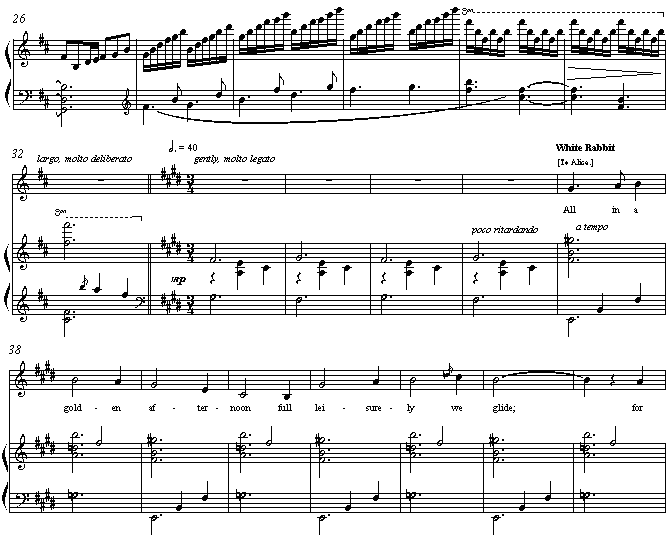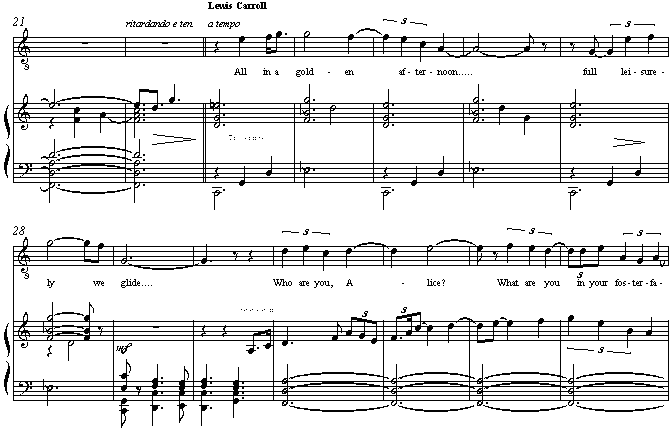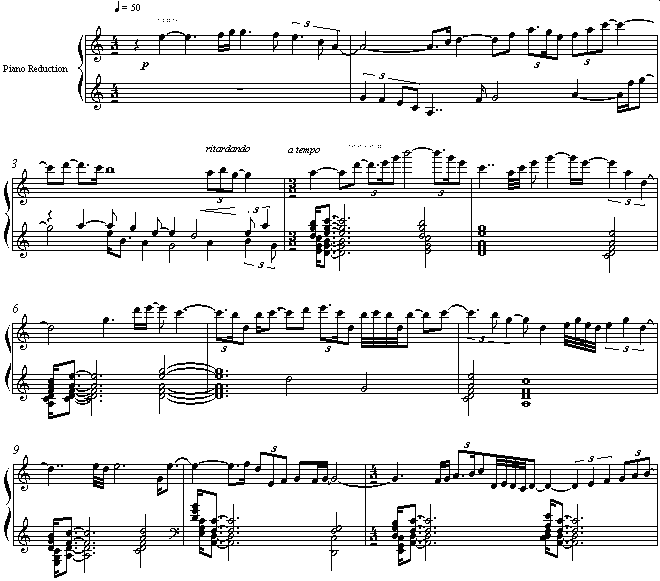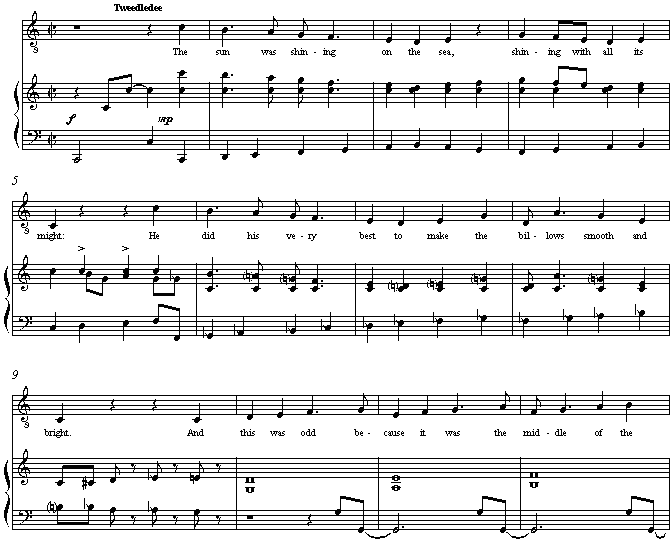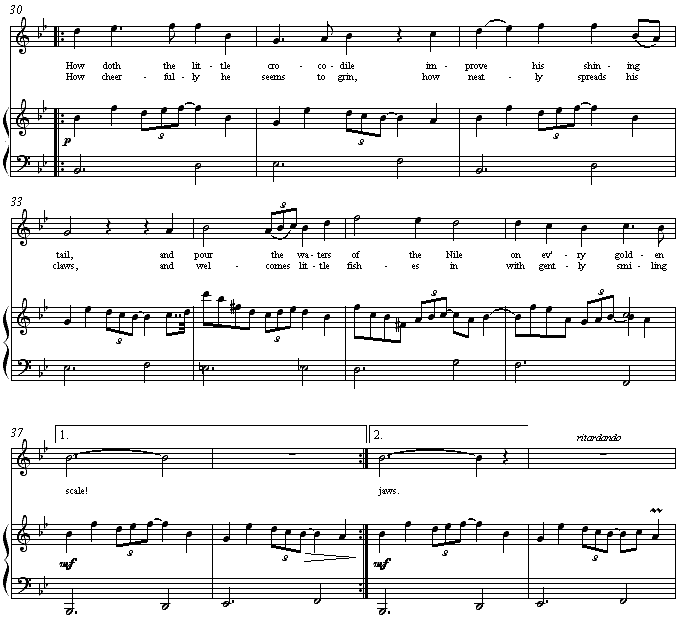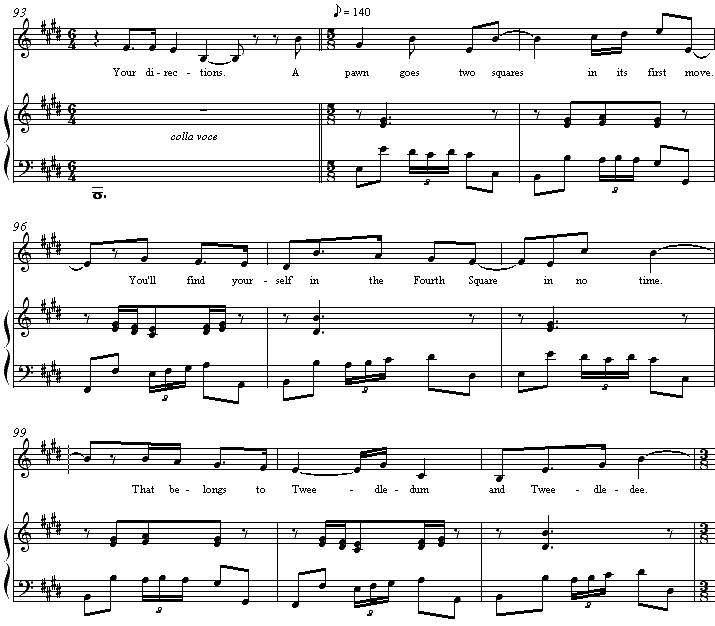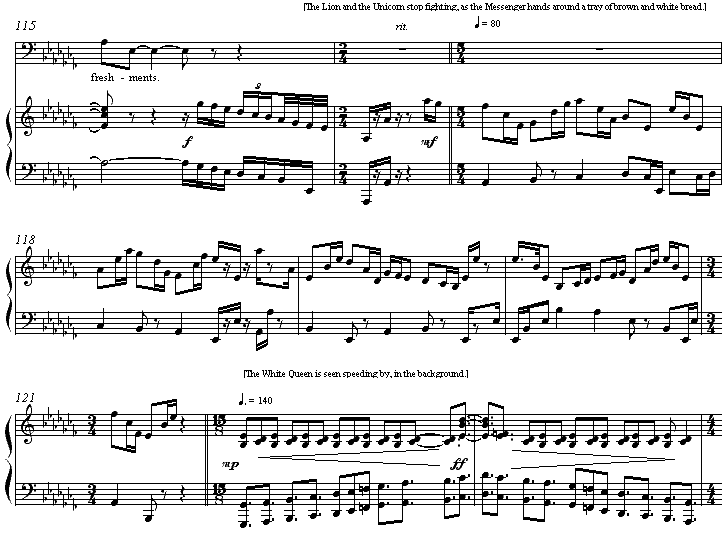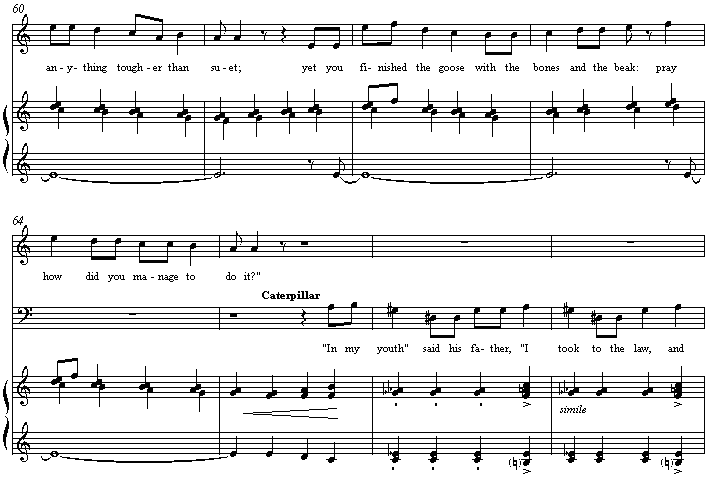Music and Texts of GARY BACHLUND
Vocal Music | Piano | Organ | Chamber Music | Orchestral | Articles and Commentary | Poems and Stories | Miscellany | FAQs
Alice - (2001-2013)
Adapted from Lewis Carroll by Gary Bachlund & Marilyn Barnett
After the stories of "Alice's Adventures in Wonderland" and "Through the Looking-Glass."
In two acts for eighteen soli (playing multiple parts) and chamber orchestra
Some Notes on the Music
Though tonal and tuneful, because the Ur-text is filled with various kinds of verbal humor, it seemed necessary to reflect varying forms of humor in the music itself. Therefore there are a number of rigorous fundamentals which may be found throughout the score, obscured by the tuneful character of the music itself but serving the goal of humor.
The Art Songs of Alice and Leitmotifs
As the original stories are filled with poetry, much of it parodies on earlier poems by others, most of these Carrollian poems have been set as art solo songs for various characters, as well as in duets and a large ensemble number in the second act. Because the stories themselves are episodic, with characters coming and going, it is Alice, of course, and Lewis Carroll who create the structure and through line of the work. Themes drawn from these art songs -- many composed as early as 1991 as maquettes towards the opera -- act as recurring leitmotifs and, as the first Wonderland adventure comes to its end, they all appear in succession truncated into one orchestral farewell.
"All in a golden afternoon," the poem which acts as a preface to the entire story, is sung by the White Rabbit -- a countertenor. The head motive of this song is given to Lewis Carroll to open his own initial address to Alice. Its melody especially recurs through the work, as these many episodic stories were first invented to entertain on such an afternoon.
In like manner, "A boat, beneath a sunny sky" which ends the edition of both stories is made to be Carroll's final soliloquy, a farewell to Alice the child, such that all the poetry of "Alice" is set to music. [ 1 ]
The leitmotif for this "golden afternoon" is simply the first phrase of one key melody:
Within the context of the scene itself, as the White Rabbit -- a countertenor -- muses over a sleeping Alice, the "art song" finds its operatic place and function. The bridge for this song form employs a "pedal," not the single note of normal musical structure but the subdominant chord which lingers through the contrary motion of melody and bass line, as is also seen in the four measure introduction.
Piano score, page 8 (Act One, scene three -- "Childhood Dreams")
That theme is the beginning gesture for Lewis Carroll's own introduction to "Alice."
Piano score, page 2 (Act One, scene one -- "Lewis Carroll's Prologue")
That same motif begins the work, a sweet melodic line to introduce Lewis Carroll (Charles Dodgson, of course) on stage alone, flanked by his own portraits of Alice Liddell.
Piano score, page 1 (Act One, scene one -- "Lewis Carroll's Prologue")
Among the humorous pre-compositional choices was the notion to make a duet for two tenors -- a rather rare occurrence in opera. [ 2 ] For this, in the second act Tweedledum and Tweedledee together "recite" the lengthy comic poem, "The Walrus and the Carpenter." The setting is a classical version of the English Music Hall style, each successive strophe rising one half step through various musical mechanisms, eleven strophes in all, rising to a final B natural for one (or both, via an alternative "ossia" if desired).
A beginning thematic element for this duet is the simple diatonic scale, infected with a wrong-note accompaniment, as the bass line strays away from the tonic major into its own unrelated tonal domain at measure 6. Various musical jokes are embedded in the strophes, each a variation of the former in some way or employing another joking stratagem to accelerate the duet to its "tragic" conclusion -- tragic for oysters, that is.
Piano score, page 163 (Act Two, scene four -- "The Walrus and the Carpenter")
The "Alice" Klang
As the central and defining character, the name of Alice has been spelled musically according to the same cipher [ 3 ] with which I spelled in tones the two works based on Marc Chagall's art work. That is, L and I are interpreted as D, after the fashion of Maurice Duruflé. [ 4 ]
The harmonic "Klang" therefore is a specific chord, whose members are A - D - D - C - E. Using the doubled note as separated by an octave, the name creates a chord structure which might be variously named based on one's preference for theory's various perspectives, but is essentially a A minor over D, suggesting initially a D minor tonality. Yet with additional transpositions related to the tonal domain of that moment, one arrives at a harmonic progression in which Alice is spelled and respelled in transpositions:
As with Strauss, this particular progression is linked together by common-tone relationships. The progression -- measures 164 and beyond -- reiterates the Alice "Klang" in several related tonal regions, a cadence on F sharp allows the confluence of this "Klang" and the number of tones in it, as the number of letters in the name itself -- five. [ 5 ]
Piano score, page 13 (Act One, scene three -- "Childhood Dreams")
Alice Is Five Letters Long
Just as with the "Klang" hiding in various guises throughout the score, the number five plays an important role in the structure of the score itself. In addition to the "ballet of doors" which happens as Alice finds herself perplexingly in Wonderland, various metrical signatures of five remind us of the her part in the story. The first poem, "How Doth the Little Crocodile" is therefore nicely set in 5/4 meter, after the ballet above in 5/8 meter:
Piano score, page 12 (Act One, scene three -- "Childhood Dreams")
Piano score, page 16 (Act One, scene four -- "Waiting by the door")
Other instances of quintuple meter are found throughout the full score. This, taken from the Caucus Race, chooses the multiple of five for a triple rhythm, fifteen, to create the "driest" musical gesture for the Mouse's recitation of some history. It is thankfully interrupted by the Lory's well chosen "Ugh."
Piano score, page 20 (Act One, scene five -- "The Caucus Race")
After other elements in this scene, the same Red Queen offers "directions" to Alice in a strict 5/8. This excerpt serves to introduce yet another building block of the score as well, the musical palindrome, of which there are many. They are often not quite literal palindromes, but musically interpreted.
Piano score, page 152 (Act Two, scene four -- "It's Like a Chess Board")
Among other quintuple meter, Lewis Carroll's paean to Alice in the opening scene of Act Two also is in a gentle 5/4 adagietto. Its strophes appear between recitative preparing for the transition from the world of Christ Church, Oxford, to the world "Through the Looking-Glass."
Alice's Musical Palindromes
When examined, the score would yield up many palindromes, such as the several to be found in Act Two's 12th scene (The Lion and the Unicorn). This, among many, defines a moment in the backwards world of the Looking-Glass when refreshments during an intermission in a battle are served. Note that the next entrance of the White Queen again is defined by a palindrome shape in the quintuple 15/8 meter.
Piano score, page 216 (Act Two, scene twelve -- "The Lion and the Unicorn")
Other Musical Humor
Visual humor which may not be aurally noted is also included in the score. One example of this shows the Caterpillar as a set of seconds crossing the musical staff in the scene, "Father William." These footprints are the last version of a chord form involving parallel seconds, sevenths and ninths, which function in the diatonic setting in a most consonant manner.
Piano score, page 35 (Act One, scene eight -- "Father William")
Quotes and misquotes from operatic and some symphonic repertoire are also found within the score, most noticeably the "Sword" leitmotif from Wagner's Ring which in this score defines the "vorpal blade" in the setting of "Jabberwocky." [This example is too well known to be included herein.] Other features include explorations into polytonal relationships within the diatonic scale, parallelism of various musical kinds, wrong note music which by its construction naturally modulates, and other subtleties which a closer acquaintance with the score would bring. Of course, false relations from a music theory point of view are thrown in for good measure.
A Cast of Players
Eighteen singers are intended to play the thirty-seven characters on stage, not counting the supernumeraries. Therefore each plays at least two, one in Wonderland and another in Through the Looking-Glass. Additionally, two take the spoken roles of Dean and Mrs. Liddell who play their parts with Dodgson in Through the Looking-Glass. The tessitura for each singer is noted in Cast List and Orchestra Details.
Alice may be taken by a lyric soprano or lyric mezzo soprano, depending on how the particular singer finds the tessitura. Lewis Carroll is composed for a lyric tenor, as are his alter egos, the Gryphon who assist in instructing Alice and White Knight who rescues her. The White Rabbit is a countertenor, to draw the audience into another land and musical genre, and plays a part only in Act One's Wonderland.
Among the voices in the cast, there is a "skirt" role for bass or bass-baritone, the Queen of Hearts. This onstage character is intended to intimidate, though comically, and tower physically, dramatically and vocally over the tenor cast to play the King of Hearts.
But First and Foremost....
But first and foremost, much of this classically oriented score is simply fun to sing, as is the text fun to read. Stephen Sondheim's modern advice is heeded, that tunes need be "hum-mum-mumable." Duly noted. [ 6 ]
Suffice it to say that the full score, while presenting a tuneful and pretty face, is also extremely rigorous in interpreting the range and breadth of Lewis Carroll's humor in these world-famous, seminal texts.
NOTES
[ 1 ] The singular exception to all "Alice" poems being set to music is the poem which is not a part of the stories, entitled "Christmas-Greetings" (1867), and the practical fact that three of the longest poems had to be edited down for the sake of length in moving the story forward.
[ 2 ] The few duets for tenor include those of Claudio Monteverdi (1567-1643), Giacchino Rossini (1792-1868) and a protégé of Rossini, Saverio Mercadante (1795-1870). I leave it to opera enthusiasts for tenor duets to create their own exhaustive list.
[ 3 ] My choice of this cipher, which I have used in other works for burying hidden meanings as much as for pre-compositional exercises, has allowed the hiding of yet other names and words, which I will not herein document. They are for the theorists at heart to discover, as Carroll's asks his audience to "dish-cover" a riddle. Musical riddles are hidden in the score, only some of which are documented. I have hidden references to Carroll as to others and myself in the score as well, perhaps too deep or across to large a time span to be easily "dish-covered."
[ 4 ] Works employing the same cipher to spell C-H-A-G-A-L-L: The Jerusalem Windows for organ (1993) and Chorales, Ariosos and Fugues on "Chagall" (1995) for piano.
[ 5 ] "The Little Crocodile," originally a sketch towards "Alice," was composed in 1991, first published as a cycle titles "Alice Songs" by Yelton Rhodes Music in 1996, and subsequently republished in the Knight Letter, a journal of The Lewis Carroll Society of North America, Number 60, Summer 1999, page 19.
[ 6 ] Moreover, this same advice comes from a seemingly unlikely source, the German stage director, Harry Kupfer. In an interview given to Volker Blech on the occasion of his retirement from Berlin's Kommische Oper ("Britten als lezte Fallstudie: Harry Kupfer verabschiedet sich als Chefrigisseur der Kommischen Oper"), this seminal figure in modern German theater is quoted as answering a question about the unhappy trend in modern opera away from melody, "Perhaps it is because today's composers are afraid to invent a melody. Because when a composer thinks one up, he is thought of as "old fashioned." But the public today likes melody. So do I."
I add editorially that, while some also deem my music old-fashioned, I too like melody, as does the public at large. I thank Harry Kupfer for his honesty in an age when much contemporary classical music and the aesthetic postures which surround it have become so dishonest.
The American composer and director of his own concert series which ran for many years, Mark Carlson, states in his Pacific Serenades brochure in 2006, "As someone raised and educated in California, I was painfully aware that the major composition prizes, as well as publishing and recording contracts, were always awarded to people from New York, Boston and Philadelphia. And then, after seeing and being part of the tonal music revival here in Los Angeles in the early 70s, I was astounded when I read New York critics crediting the rediscovery of tonality to East Coast composers in the 80s."
Mark, for whose concert series I composed a commissioned work, and many like-minded colleagues feel the reality is that tuneful, tonal yet modern classical music has continued to be written around the world, if not always appreciated by or approved of by the musical powers that be. Neither the approval nor appreciation by musical power brokers changes the reality made clear by Kupfer's honest observation, "...the public likes melody."
In time, the best of modern melodic classical music will take its rightful place, just as did, for example, the great works of Toulouse-Lautrec, whose works were targeted for disapproval and destruction by an "approved" artistic elite in Paris whose members held power and sway for the moment, but whose works today are deemed marginal at best and certainly of lesser merit and standing than the opera omnia of Toulouse-Lautrec in the perspective of art history. This is a lesson wrote revisiting, for those artists and composers whose spirit may from time to time weaken in the face of the musical "political correctness" which assails and attempts to enforce aesthetic tastes.

